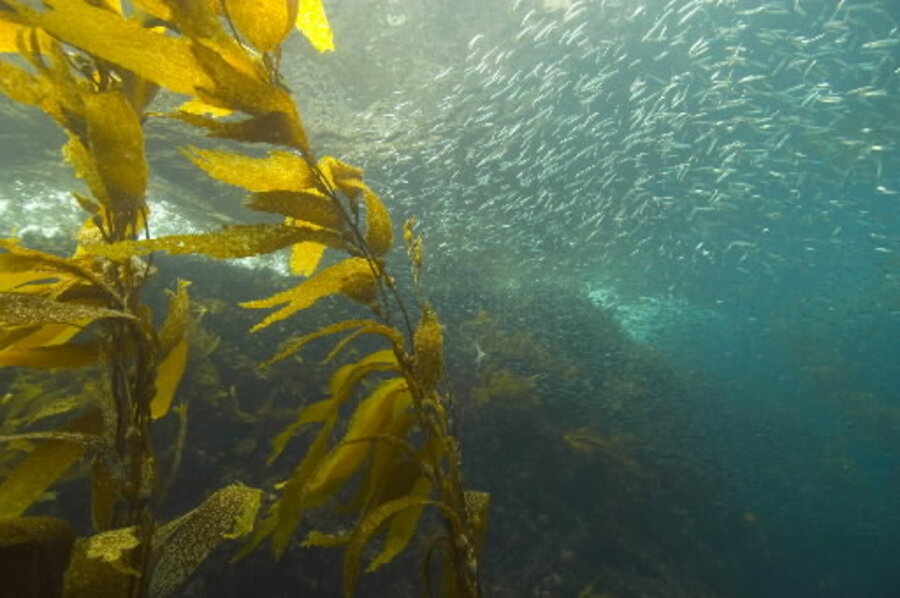Another victim of climate change: kelp
Loading...
Kelp, with its incredible ability to overcome biological stressors and grow back quickly, is an important indicator of how healthy the ocean is.
As such, two studies published recently in the Proceedings of the National Academy of Sciences, attempted first to quantify the health of kelp forests around the globe, and then to determine what can cause this resilient species to enter a large-scale decline and how that impacts the ecosystem as a whole.
“When kelps show dramatic changes, increases or decreases, that indicates that there has been a real change in the ecosystem,” Jarrett Byrnes, co-author of the first study and an assistant professor of biology at University of Massachusetts, Boston, tells The Christian Science Monitor. “Kelps are very resilient, they respond very quickly after environmental predation. Anything that can drive a long-term change in a kelp population has got to be pretty big.”
Kira Krumhansl, a postdoctoral fellow at Simon Fraser University in British Colombia who led the first study, looked at the whether kelp populations were more impacted by local stressors, such as poor water quality and overfishing, or global stressors, such as ocean temperature warming cause by human activity.
By analyzing kelp abundance at more than 1,000 sites across the globe, Dr. Krumhansl and her team determined that 38 percent of the world’s kelp forests have declined over the past 50 years, while 25 percent have increased. The lack of a global trend in the health of kelp forests suggests that it is the regional differences that drive the success of failure of a kelp population more than the global factors.
“Climate change is impacting kelp forests, but what really drives variation across regions is what is occurring at a local scale,” Krumhansl tells the Monitor. “Kelps’ ability to persist through sources of stress is attributed to their capacity to grow quickly and recover quickly, but this also indicates that where we do see decline in kelp we are really tipping the level of stress over a critical threshold beyond which these species can recover.”
Picking up on that line of reasoning, the second study looked into a kelp population in Australia that may have tipped over that threshold because of an invasion of tropical herbivorous fish into the New South Wales Sea that have been eating the kelp.
Using video footage from 12 kelp forest sites between 2002 and 2011, the research team from University of New South Wales in Australia (UNSW) observed that while only 10 percent of kelp showed bite marks from fish in 2002, six years later 70 percent of kelp had been chewed.
The dramatic kelp deforestation coincided with an 0.6 degree Celsius temperature rise in the New South Wales Sea, which ushered in a 20 percent increase in various species of tropical fish in the ecosystem – in a phenomenon called tropicalization.
“We call it a homogenization of community,” Adriana Vergés, a researcher in the School of Biological, Earth and Environmental Sciences at UNSW, told The Guardian. “It’s a bit like globalization – everything starts to become the same everywhere.”
By eating the kelp, these non-native tropical fish disrupt the ecosystem.
Peter Steinberg, the director of the Sydney Institute of Marine Science who contributed to the UNSW study, told The Guardian the damage that the fish – and by association the temperature change – caused to this kelp forest ecosystem was concerning because it showed that tropicalization could be triggered by a smaller increase in ocean temperature than expected.
While kelp have proven they can survive in warmer waters, although they thrive at cooler temperatures, those warmer waters bring with them other environmental changes that can prove to be too much for the kelp. Therefore the temperature range that will initiate a massive kelp decline increase, which is bad new for the species and processes that in turn depend on kelp.
“Kelp forests are important ecosystems because they support diverse communities of organisms in coastal zones, including many fishery species, and they provide a mechanism of carbon storage in coastal zones, they shelter shorelines from incoming wave actions,” Krumhansl told the Monitor. “They prove a number of benefits to humans, they are really critical for our livelihood and survival.”






